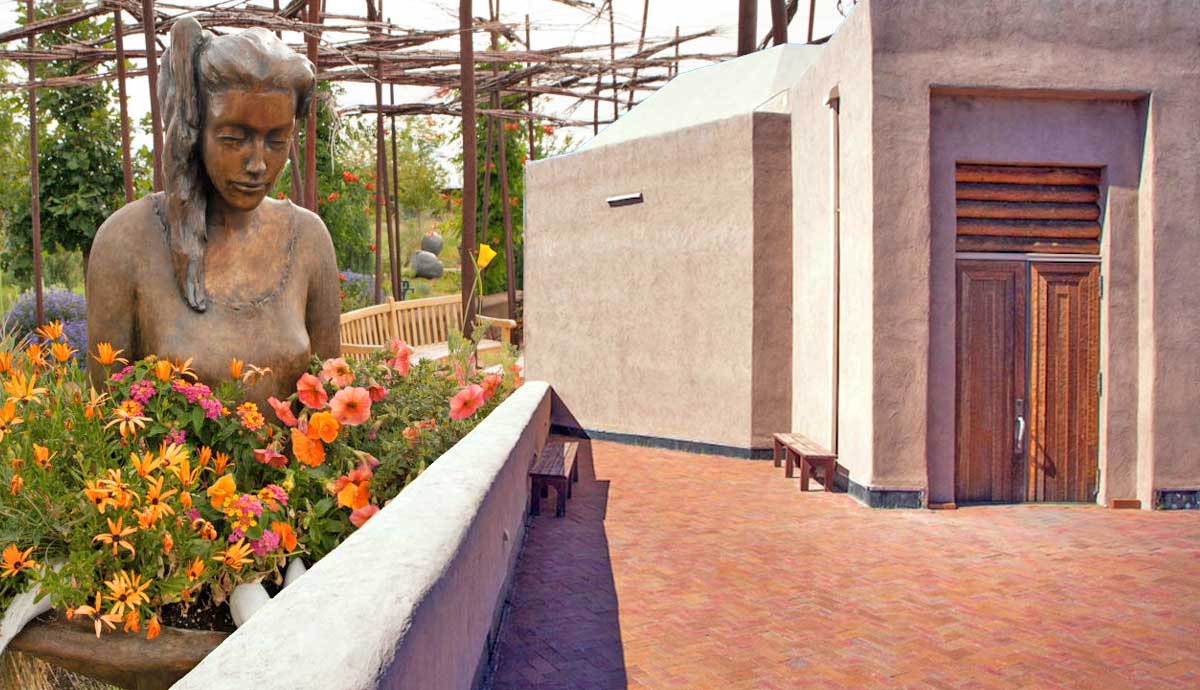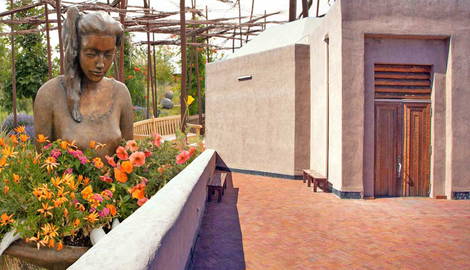
Just two miles southeast of downtown Santa Fe, New Mexico, lies Museum Hill. It’s worth spending a day or two at this popular destination for art, history, and nature. On the hill overlooking the historic city of Santa Fe are four world-class museums and an expansive botanical garden. Whether you love history or fine art, there’s something for everyone. Museum Hill is a must-see Santa Fe monument dedicated to the region’s rich artistic and cultural legacy. Here are five places you should visit here.
1. Santa Fe’s Wheelwright Museum of the American Indian

The Wheelwright Museum of the American Indian is one of Santa Fe’s most esteemed museums. It is a center for Native American art and culture and the first museum built on top of the Museum Hill. The museum was opened in 1937 as the Museum of Navajo Ceremonial Art. The heiress Mary Cabot Wheelwright and Hosteen Klah, a Navajo healer and ceremonial practitioner, teamed up to create a center for Navajo ceremonial art and traditional ceremonies. It soon became one of the region’s most important Native American art centers, attracting thousands of visitors each year.
In 1977, the museum repatriated its ceremonial items and added an expansive collection of North American Native art. Its main exhibition gallery was converted into the Klah Gallery, in honor of the museum’s founding member. Inside the museum, you can find the permanent gallery called the Center for the Study of Southwestern Jewelry. There are thousands of Navajo, Hopi, Zuni, and Pueblo pieces of jewelry that showcase over three centuries of traditional techniques here. You’ll see traditional beadwork, weaving, metalwork, and pieces that utilize the seeds and wood of local plants.
The museum’s other revolving galleries display various collections of Native American art, with an emphasis on the Southwest. You’ll learn about the artists, their community, and more about the artistic heritage and traditions each artist employs. There are also thought-provoking exhibits showcasing modern art from some of the most well-known Native American artists.
The Wheelwright Museum of the American Indian also hosts community-centered events that promote Native American art and art education. Speakers, community leaders, artists, and museum coordinators conduct lectures and demonstrations for the public, making the museum a center for family fun, art, and community.
2. Museum of International Folk Art

Since 1953, the Museum of International Folk Art has stood as an iconic art center and community space for the city of Santa Fe. Inside are over 150,000 pieces of global folk art spanning several centuries, making it the largest folk art museum in the world. The Museum of International Folk Art started as a passion project by Florence Dibell Bartlett. Bartlett was a visionary Chicagoan with a vast fortune and a desire to bridge the world’s differences through art. Eight months after the museum opened, Bartlett passed away. Since then, the museum has expanded its collections that represent folk art traditions from every corner of the globe.
The large museum has five wings that feature a diverse range of traditional art. The Bartlett wing features the finest collection of international folk art. In addition, there’s the Girard wing, the Hispanic Heritage wing, and the Neutrogena wing which features a collection of textiles of the company’s former CEO Lloyd Cotsen. Finally, there’s the newest section called the Gallery of Conscience which examines the threats to the world’s traditional arts.
On top of its expansive and evolving collections, the museum continues to further the study and preservation of international folk art. There are interactive events for folk artists of all ages. The museum also hosts performances, poetry readings, and live folk art demonstrations by internationally renowned folk artists. One of the major draws for visitors and art fans is the Bartlett Library, located on site. This immense collection of books, manuscripts, and documents chronicles the world of folk art. For scholars, artists, and art historians, the library’s collection has the best sources on international folk art in the United States.
3. Museum of Indian Arts & Culture

Just north of the Museum of International Folk Art stands the Museum of Indian Arts & Culture. It’s one of Santa Fe’s most important museums dedicated to Native American art and culture. It’s also an important center for preserving art traditions and features community educational programs and workshops. As you enter the museum, you’re surrounded by 80,000 pieces, ranging from archeological wonders to contemporary Native American art. Some of the museum’s highlights are included in the Here, Now and Always exhibition. This permanent exhibition showcases stories, artifacts, and reflections of the Native People of the American Southwest. It’s a reflective space with endless information on the region and its history, art, and traditions.
The Museum of Indian Arts & Culture started as a merger between the Museum of New Mexico and the Laboratory of Anthropology in 1947. After three decades of expanding its collections, the laboratory began raising funding for a museum space in 1977 so the public could experience the artifacts and learn about their cultural significance. In 1987, the Museum of Indian Arts & Culture opened its doors. In addition to its diverse and significant collections and artifacts, the museum is both a community center and an educational center that continues research into the cultures of the American Southwest. Every month, you can enjoy guest lectures featuring Native American artists, historians, scientists, and leaders. There are also art workshops where professional artists teach traditional art to visitors of all ages.
After visiting, don’t miss the museum shop. Here, you can buy a wide range of traditional art, ceramics, books, and jewelry. The shop also sells glasswork created by some of Santa Fe’s top glassblowers.
4. Museum of Spanish Colonial Art

At the northern end of Museum Hill is the smallest museum—the Museum of Spanish Colonial Art. For over two centuries, from 1607 to 1821, the city was a frontier trading, military, and religious post for the Spanish Empire. During this time, Santa Fe grew into an influential community that linked some of the biggest settlements in Spanish North America. Trade between Spanish, Native American, Mexican, and cultures across the United States helped create the culture of New Mexico.
The Museum of Spanish Colonial Art showcases the art, artifacts, and other objects acquired during this period. Its purpose is to tell the story of the people who lived in Santa Fe during Spanish rule. You’ll learn about the often brutal history of the city’s early settlement and its struggles. You’ll also find over 3,000 artifacts, including furniture, weaponry, clothing, and many more items from Spanish Santa Fe. Other items include art, ceramics, metalworks, and preserved books. It’s the only museum in the United States dedicated entirely to Spanish Colonial art.
The museum hosts events like traditional Spanish dancing and art education. It’s also home to the popular Spanish Market. Every year, thousands of people visit the museum and its market to purchase traditional Spanish folk art and enjoy the festivities.
The museum’s history dates back to 1925 when writers Mary Austin and Frank Applegate established its initial collection and formed the Spanish Colonial Arts Society. The architect John Gaw Meem designed and built the current building in 1930 in the Pueblo Revival style. In 1998, it was donated to the Society, and in 2002, the Museum of Spanish Colonial Art opened its doors to the public.
5. Santa Fe Botanical Garden

After enjoying Museum Hill’s collections, you can experience the native flora of the area at the Santa Fe Botanical Garden. A huge portion of the city’s art, culture, and history revolves around the dry and beautiful landscape of northern New Mexico. You’ll see depictions of the native plants and landscapes sacred to the local Native American communities. At the botanical garden, you can learn about this influential and culturally significant landscape.
The garden was opened in 2006 when a group of botanists and local community leaders acquired 14 acres of land on Museum Hill. The city gave the group the green light to build the city’s only botanical garden. It has since become one of Museum Hill’s highlights.
Starting at the entrance are the orchard gardens. This section features fruit trees, native wildflowers, and grasses that reflect the area’s agricultural history. From here, you’ll get to walk through the popular art trail. You’ll see large and small sculptures designed by local artists that feature images of local plants, animals, and sacred objects. The art trail leads to the dry Xeric Garden, which is made up of plants native to the barren highlands surrounding Santa Fe.
After crossing the iconic red bridge, you’ll enter Horno Plaza. This is where the botanical garden hosts educational and cultural events, such as lectures, art workshops, and dances. Surrounding the plaza is the ethnobotanical area. Here, you can learn about the plants that the Indigenous communities of the area relied on to thrive in the harsh landscape of New Mexico.
From here, you’ll stroll through the extensive piñon-juniper woodlands. These beautiful plants cover the mountains surrounding Santa Fe and are home to the region’s diverse animal species. Every season gives a unique perspective to the garden and its art exhibitions.










